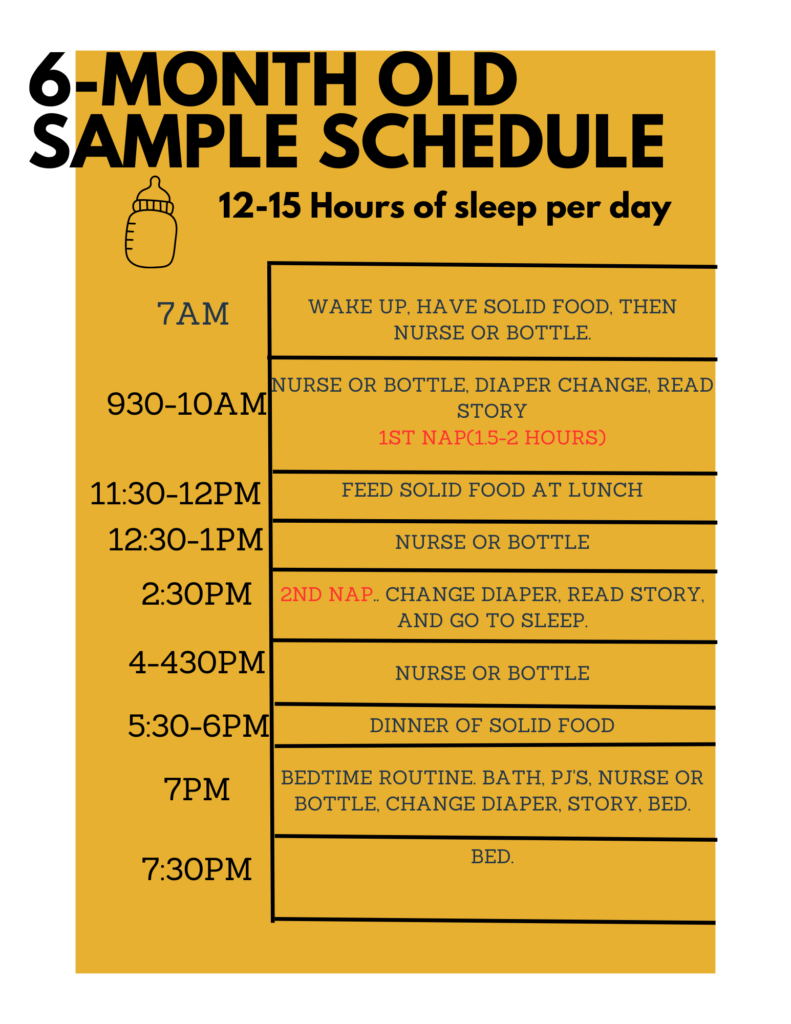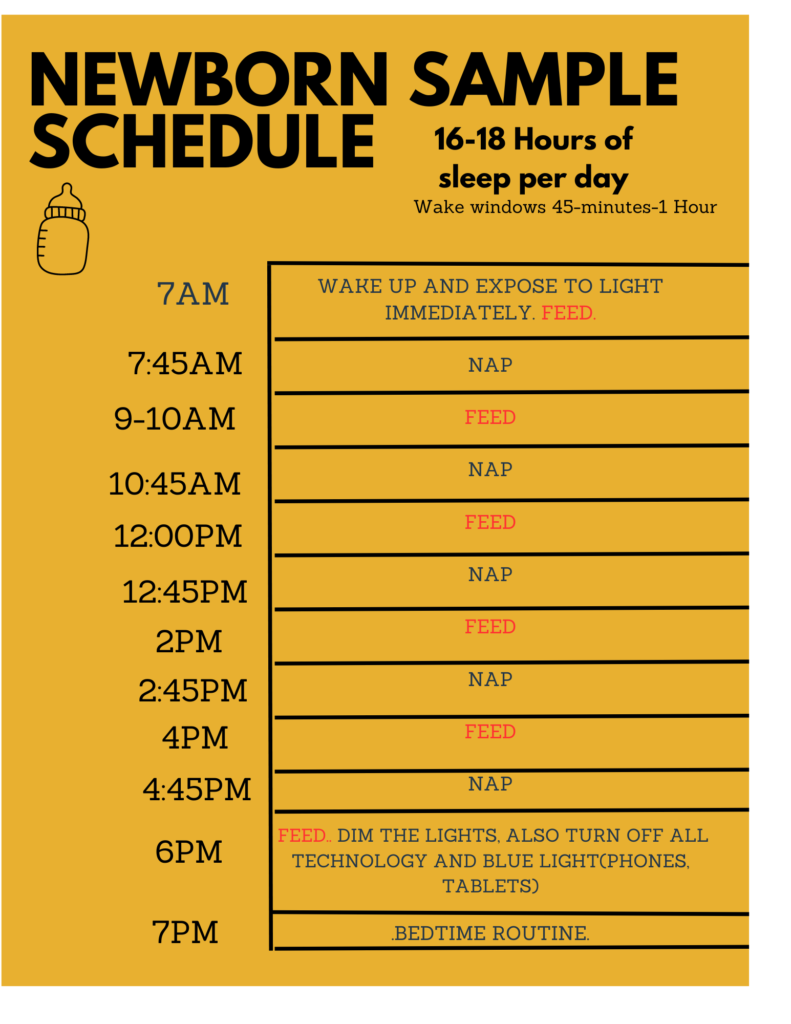How often should a baby be eating? What does eating have to do with sleeping?
Here is an inside look on how and when a baby eats and how this affects their sleep. This baby feeding schedule can be customized to your baby’s age, temperament, formula, or breastmilk. When a child is getting efficient full feeds, they should be eating every 2-3 hours. The amount of time a child can tolerate being awake will depend on their age. You can find your child’s wake window here. These two things go hand in hand with sleep. Getting restorative, consolidated sleep depends on a full belly (not over feeding) and catching them before they are overtired or fatigued.

3-month old babies need 14-16 hours of sleep each day. Notice, the catnap is only necessary if there is an extended period of time between last nap and bedtime. If naps are shorter than 1.5 hours you will most likely have time for a 4th nap.
Why should you feed your child right after waking up?
When a baby first wakes up is when they will have their most energy. It is hard work for a baby to eat. Feeding them first ensures that they will (1) be hungry, and (2) that they will be efficient and get a FULL feed. When a child is getting the proper nutrients and calories they will sleep better. If your child is showing hunger cues after an hour of just feeding, they are either not eating efficiently (getting full feeds) or tired and using the breast or bottle as a soother.
Schedule order matters!
Breast and bottle are the number one prop that a baby relies on to fall asleep. We want to try and disassociate feeding with sleeping. Newborns will definitely fall asleep at the breast or bottle, and that’s ok as long as it’s not all the time. Doing an activity in between also helps them digest the food before going to sleep. This is especially helpful if your child has reflux. Keep in mind when you find your child’s wake window, that a feed counts as part of the activity. For example: Your baby is 3 months old and can tolerate 1-1.5 hours awake. If they take 30 minutes to eat, they have a 30 minute window to play before you look for sleep cues to put them down for their next nap.
Understanding your baby
Each baby will be different. Some children might need to eat at the 2 hour mark, while others can go 3-4 hour stretches. Knowing their voice and cues will give you reassurance that you are listening to them, and their needs are being met. Sleep and hunger cues get misconstrued often, because we automatically assume if a baby cries they are hungry. When in reality, a lot of times the child is not hungry but fatigued. This is very common and this flexible schedule will start to bring awareness to your child’s cues.
Catching your baby in their sleep window instead of their over tired fatigued window will give you an easier time getting them to sleep. They will also get more consolidated sleep instead of fragmented sleep. When you put your baby down for a nap or bedtime in their sleep window, it sets them up to learn self-soothing and independent sleep strategies because they are in a calm state. Instead of being overtired and agitated because they are exhausted.
How do you know if your baby is getting full feeds if they are breastfed?
Here are a couple things to look out for if you are breastfeeding:
- Listen to how they suck. You will be able to hear the milk coming from your breast after it is let down. They also use the pattern of suck suck swallow, or suck swallow, with their jaw moving up and down.
- You can pump and use a bottle to see how much they are actually drinking.
- If they are only on your breast for a couple of minutes and seem distracted, or instantly fall asleep… they were not hungry, and definitely didn’t get a full feed.
*Note: When adding solid foods into a baby’s diet, they might naturally start to drink less milk. Another thing to remember is a 6-month old should not feeding in the night. They make up for these lost calories during the day, with solid food and nursing/bottle.

Sanity for Mom
One of the hardest parts of motherhood is the unknown. Am I doing enough? Am I doing this right? Following a flexible feeding schedule gives you insight into the “knowing”. Reassurance is our best friend as we embark on this journey. Mom’s thrive off of predictability and structure just as much as their little one. Knowing first that your child’s needs are being met is so satisfying. Knowing when the naps and feedings will be, you can plan your day accordingly and know what to expect. Get excited to learn about your baby!!!
Last but not least.
You can start this routine the first day home from the hospital and avoid creating bad habits in the future. It might look all squished together for the first month but trust me, it will evolve.
Newborn Schedule: Note this is extremely flexible. Most important things to remember, full feeds after waking up, naps, and developing their biological clock(differentiating night from day).
16-18 hours of sleep per day. Wake window 45 minutes to 1 hour.

A bedtime routine can be around 20-30 minutes and look something like this: Bath, dim the lights, pajamas, nurse or bottle, change diaper, read books, lay the baby down on their back awake.
Your baby will wake up when they are hungry every 2-3 hours until they develop their biological clock. Give them opportunities to learn self-soothing skills by laying them down awake for one nap a day, or at bedtime. Wait 5 minutes before responding. Babies naturally wake up between sleep cycles, and are also very noisy sleeps. Make sure they are actually awake before picking them up to see to their needs.
Looking for a customized schedule for your baby and unique family unit? Head over to our website to see all the programs we have to offer.
Did you know we offer toddler, older children and adult sleep programs as well? Click here!
Resources:
Children’s Growth and Development
Lactation Consultants:
[…] Baby Feeding Schedule […]